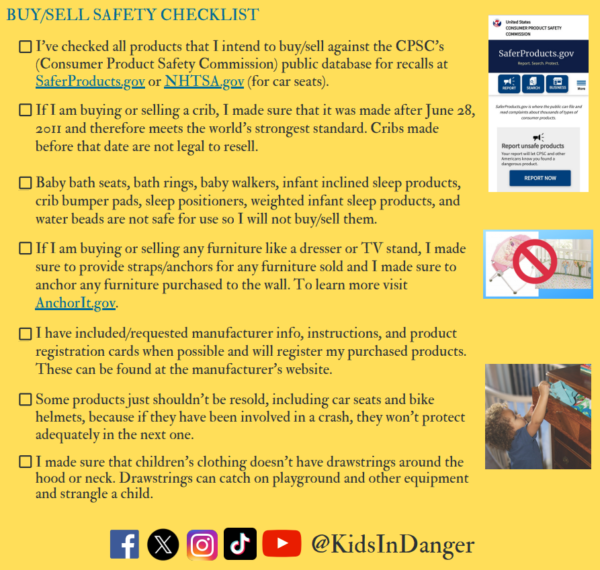Secondhand Products
In 2012, KID conducted a consumer report study on incidents, injuries, or deaths associated with cribs. Unfortunately, we found that despite recent improvements in standards for cribs, unsafe cribs continue to be widely used in nurseries. Twenty percent of cribs involved in incidents were recalled models. Fourteen percent of those were recalled at the time the family purchased the crib—usually second hand. The dangers of second hand products go beyond cribs, and include any type of product.
 Pre-owned items present their own special hazards, including wear from previous use and failure to conform to current safety standards. KID urges everyone to be aware that recalled and other dangerous children’s products commonly show up in many places, such as in garage sales, church rummage sales, and as hand-me-downs. When buying, selling, donating or receiving second hand items, complete this safety checklist to help keep kids safe from unsafe products.
Pre-owned items present their own special hazards, including wear from previous use and failure to conform to current safety standards. KID urges everyone to be aware that recalled and other dangerous children’s products commonly show up in many places, such as in garage sales, church rummage sales, and as hand-me-downs. When buying, selling, donating or receiving second hand items, complete this safety checklist to help keep kids safe from unsafe products.
More guidelines for safety and second hand products
Remember to check all products you buy or sell against CPSC’s recall listings. Sign up for CPSC’s Email Announcements of all recalls (Spanish version available) and KID’s monthly Email Alerts listing all child product recalls and safety information. Avoid buying or selling used cribs, car seats, and bike helmets which may be unsafe due to involvement in an accident, missing or broken hardware, or not meeting current safety standards. In addition, do not buy or sell walkers, bath seats, and sleep positioners as these are not safe for use. Only buy or sell children’s jewelry, toys, and durable goods such as play yards, strollers, and highchairs if they are certified as meeting current standards. Do not buy or sell items that are broken or have missing pieces, especially if they require assembly. Beware of products with protruding hardware or rotating rails that do not properly lock into place. Include manufacturer information, instructions, and product registration cards when possible. These are sometimes available on the manufacturer’s website. Drawstrings and ties on clothing should be removed as they pose strangulation hazard.
